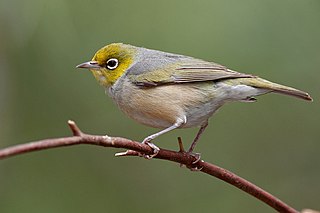
The silvereye or wax-eye, also known by its Māori name tauhou, is a very small omnivorous passerine bird of the south-west Pacific. In Australia and New Zealand its common name is sometimes white-eye, but this name is more commonly used to refer to all members of the genus Zosterops, or the entire family Zosteropidae.

The vastus lateralis, also called the vastus externus, is the largest and most powerful part of the quadriceps femoris, a muscle in the thigh. Together with other muscles of the quadriceps group, it serves to extend the knee joint, moving the lower leg forward. It arises from a series of flat, broad tendons attached to the femur, and attaches to the outer border of the patella. It ultimately joins with the other muscles that make up the quadriceps in the quadriceps tendon, which travels over the knee to connect to the tibia. The vastus lateralis is the recommended site for intramuscular injection in infants less than 7 months old and those unable to walk, with loss of muscular tone.
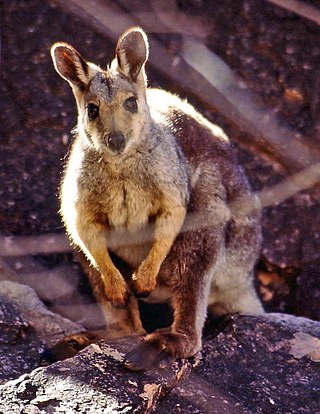
The black-flanked rock-wallaby, also known as the black-footed rock-wallaby or warru, is a species of wallaby, one of several rock-wallabies in the genus Petrogale. A shy, nocturnal herbivore, its two main subspecies are found in mostly isolated populations across western and southern Western Australia (WA), the Northern Territory and parts of South Australia (SA). With some subspecies showing a decline in populations in recent years, the whole species is classed as an endangered species under the Commonwealth EPBC Act.

Periplaneta is a genus of cockroaches containing some of the well-known pest species with cosmopolitan distributions, such as:
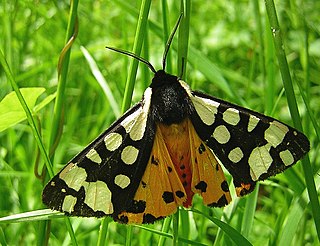
The Arctiina are a subtribe of moths in the family Erebidae.
Paracles is a genus of moths in the subfamily Arctiinae. The genus was described by Francis Walker in 1855. The species range from Panama to Patagonia, with quite a few in the southern temperate region of South America.
Pheia is a genus of moths in the subfamily Arctiinae erected by Francis Walker in 1854.

Lymantria is a genus of tussock moths in the family Erebidae. They are widely distributed throughout Europe, Japan, India, Sri Lanka, Myanmar, Java, and Celebes. The genus was erected by Jacob Hübner in 1819.

Addisonia is a genus of sea snails, marine gastropod mollusks in the family Addisoniidae.

Shelfordella was a genus of cockroaches found in north-east Africa and Asia, through to western India; it is now considered a synonym of Periplaneta.
Paracles surgens is a moth of the subfamily Arctiinae first described by Francis Walker in 1865. It is found in Colombia and Peru.
Paracles antennata is a moth of the subfamily Arctiinae first described by Francis Walker in 1865. It is found in Colombia.

Paracles contraria is a moth of the subfamily Arctiinae first described by Francis Walker in 1855. It is found in the Amazon rainforest of Brazil, French Guiana and Bolivia.

Paracles fusca is a moth of the subfamily Arctiinae first described by Francis Walker in 1856. It is found in Brazil and Argentina.
Paracles sericea is a moth of the subfamily Arctiinae first described by William Schaus in 1896. It is found in Brazil.

The Turkestan cockroach, Periplaneta lateralis, also known as the rusty red cockroach, red runner cockroach or simply rusty red, red runner, or lat, is a primarily outdoor-dwelling cockroach native to an area from northern Africa to Central Asia. Adults measure around 3 cm (1.2 in) in length. Adult males are a brownish orange or red, are slender, and have long, yellowish wings which allow it to attract females and to glide. Adult females are dark brown to black, with cream-colored markings on the shield and a cream-colored stripe edging its wings; they are broader than males, and have short vestigial wings. Nymphs are brown in front, black on the rear, and are wingless.
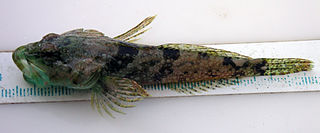
Artedius lateralis, also known as the smoothhead sculpin or round-nosed sculpin, is a species of marine ray-finned fish belonging to the family Cottidae, the typical sculpins. The species, commonly found in the intertidal zone and to depths of 43 feet, is native to the northern Pacific, from Russia and the Bering Sea to Baja California. Growing to a length of 14 centimeters, it takes its name from the lack of scales on its head.
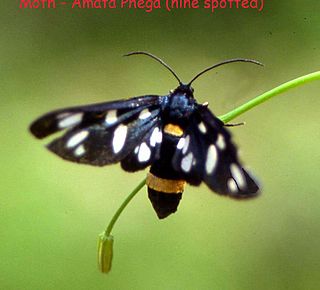
The Syntomini are a tribe of moths in the family Erebidae. The tribe was erected by Gottlieb August Wilhelm Herrich-Schäffer in 1846.
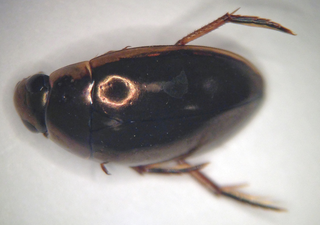
Tropisternus lateralis is a species of hydrophilid beetle that ranges across much of the Americas.













